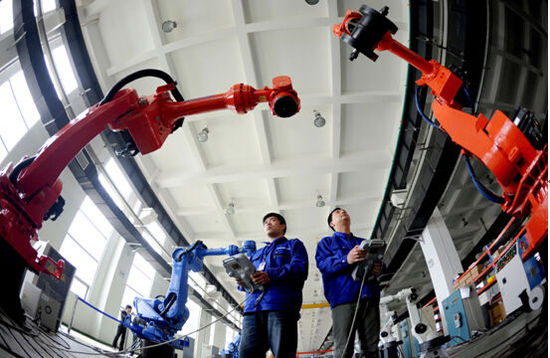Northeastern industrial base showing signs of revival

Workers assemble robotics in a Siasun Robot and Automation Co Ltd plant in Shenyang, capital of Liaoning Province. Innovation is attracting attention in the new round of revitalization.
To mark the arrival of spring, Song poet Zhang Lei wrote: “The lingering snow melts into water drops and willow branches begin to sprout.” These words are appropriate to describe the changes in Northeast China. In the first half of 2017, Liaoning Province reversed its negative growth trend, achieving a 2.1 percent increase in GDP. Also, the GDP of Jilin grew by 6.5 percent and that of Heilongjiang, 6.3 percent. A number of old industrial cities in the region have begun to recover from their economic slump. GDP and the local fiscal revenue of Changchun, capital of Jilin Province, both have risen by 8 percent, the highest rate in the last three years.
“Currently, the economy of Northeast China is becoming stable and positive factors are accumulating. The economy is gradually bottoming out,” said Zhou Jianping, director of the department of revitalization under the National Development and Reform Commission in a recent forum on that topic. “The country has introduced a series of policies to revitalize Northeast China, and the dividend of these policies will continue to take effect,” said Liu Changlong, mayor of Changchun.
“The central government has issued a variety of core documents on the revitalization of Northeast China, which laid a solid foundation for the overall rejuvenation of the region,” said Zhao Ji, president of Northeastern University.
Innovation-based development is attracting attention in the new round of revitalization. In 2016, the State Council released goals under the 13th Five-Year Plan to build the region into a crucial base for technological innovation and R&D. At present, the three provinces are following the orientation of national policies and implementing supply-side structural reform to transform and upgrade such industries as petrochemicals, automobile manufacturing and agricultural products processing. They are also actively developing new industries like smart equipment, new materials, robotics, medicine and health services.
Six strategic emerging industries of Changchun grew by 13.3 percent in the first half of 2017, including advanced equipment manufacturing, biopharmaceutics, new energy vehicles and new materials. Harbin, capital of Heilongjiang Province, has launched a number of innovations in the fields of robotics, new materials and big data, increasing the added value of local high-tech industries to more than 100 billion yuan. Also, the output of high-tech products in Shenyang, capital of Liaoning Province, now accounts for 55 percent of that of above-scale industry.
“The key to translating innovative advantages into research capabilities is to create a favorable environment for creativity and emphasize the role of enterprises,” said Jiang Youwei, mayor of Shenyang. At present, Shenyang has established 44 innovation alliances for such industries as robotics and unmanned aerial vehicles as well as 290 technological centers. In the first half of 2017, there were a total of 9,792 patent applications in the city, a 21 percent increase year-on-year.
Zhou believes that the region is bound to rapidly develop emerging industries, like new materials, medicine and health, winter tourism while service sector and strategic emerging industries are accounting for an increasingly bigger proportion in economy. For example, Heilongjiang Province has increased its total economic output, energy industry excluded, by about 300 billion yuan over the past five years. The optimization of industrial structure has taken effect.
Development and opening-up has injected new vitality into the region’s economic development. In recent years, Northeast China has constructed high-speed railway networks and integrated with the “Belt and Road” initiative while actively establishing platforms for cooperation with Northeast Asia. Also, the three provinces have constantly strengthened coordination among provinces and regions by setting up opening-up platforms, such as economic belts and various types of new zones.
One highlight of regional economic development is the rapid growth of small, medium-sized and micro enterprises, which have formed a clear division of labor and closely cooperate with one another. Take Changchun for example. In the first half of 2017, the output of small enterprises rose by 9.7 percent and that of medium-sized enterprises grew by 13.1 percent. Growth in both types outpaced that of large enterprises. These enterprises and private companies have become new engines for economic development.
In the past, some people in Northeast China were set in their ways. They often gave themselves over to idleness and had nothing to do in winter to escape from the cold weather. Their outlook is starting to change. People there have become active during winter too and are working to live a better life.
Li Fengmei in Huinan County, Jilin Province was extremely busy throughout last winter. Her agritainment business received an average of more than 200 customers per day. “In the past, villagers used to drink, play cards and Mahjong in winter,” Li said. The town has recently built an ice and snow park as well as a ski resort, attracting winter tourists to the area. People no longer stay idle because the number of tourists is increasing.
In addition, Jilin Province has set up 43 e-commerce service centers at the county level and more than 13,000 e-commerce service stations in villages in 2016. Its e-commerce trade volume in rural areas has hit 10 billion yuan, benefiting 250,000 farmers across the province. “The arrival of e-commerce in villages has enabled the circulation of agricultural products and shifted the attitude of farmers whose lives solely relied on their farming land,” said Lin Zhe, deputy director of the Dunhua Municipal Bureau of Commerce in Jilin Province.
“‘Busy winter’ has not only created a broader market, but also revitalized people’s state of mind in Northeast China,” said Fu Cheng, director of the Institute of Sociology at the Jilin Academy of Social Sciences.

 PRINT
PRINT CLOSE
CLOSE